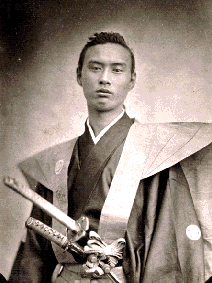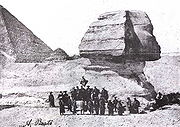
Second Japanese Embassy to Europe (1863)
Encyclopedia

Tokugawa shogunate
The Tokugawa shogunate, also known as the and the , was a feudal regime of Japan established by Tokugawa Ieyasu and ruled by the shoguns of the Tokugawa family. This period is known as the Edo period and gets its name from the capital city, Edo, which is now called Tokyo, after the name was...
. The head of the mission was Ikeda Nagaoki
Ikeda Nagaoki
, formally "Ikeda Chikugo no kami Nagaoki", was the governor of small villages of Ibara, Bitchū Province , Japan, during the end of the Tokugawa shogunate....
, governor of small villages of Ibara
Ibara, Okayama
is a city located in Okayama, Japan.As of 2008, the city has an estimated population of 44,271 and the density of 182 people per km². The total area is 243.36 km².The city was founded on March 30, 1953...
, Bitchū Province
Bitchu Province
was a province of Japan on the Inland Sea side of western Honshū, in what is today western Okayama Prefecture. It was sometimes called , with Bizen and Bingo Provinces. Bitchu bordered Hōki, Mimasaka, Bizen, and Bingo Provinces....
(Okayama Prefecture
Okayama Prefecture
is a prefecture of Japan located in the Chūgoku region on Honshū island. The capital is the city of Okayama.- History :During the Meiji Restoration, the area of Okayama Prefecture was known as Bitchū Province, Bizen Province and Mimasaka Province.- Geography :...
). The assistant head of the mission was Kawazu Sukekuni.
The objective of the mission was to obtain French agreement to the closure of the harbour of Yokohama
Yokohama
is the capital city of Kanagawa Prefecture and the second largest city in Japan by population after Tokyo and most populous municipality of Japan. It lies on Tokyo Bay, south of Tokyo, in the Kantō region of the main island of Honshu...
to foreign trade. The mission was sent following the 1863 "Order to expel barbarians
Order to expel barbarians
The was an edict issued by the Japanese Emperor Kōmei in 1863 against the Westernization of Japan following the opening of the country by Commodore Perry in 1854.-The order:...
" (攘夷実行の勅命) edicted by Emperor Kōmei
Emperor Komei
was the 121st emperor of Japan, according to the traditional order of succession. Kōmei's reign spanned the years from 1846 through 1867.-Genealogy:Before Kōmei's accession to the Chrysanthemum Throne, his personal name was ;, his title was ....
, and the Bombardment of Shimonoseki
Bombardment of Shimonoseki
The Battles for Shimonoseki refers to a series of military engagements in 1863 and 1864, fought to control Shimonoseki Straits by joint naval forces from the Great Britain, France, the Netherlands and the United States, against the Japanese feudal domain of Chōshū, which took place off and on the...
incidents, in a wish to close again the country to Western influence, and return to sakoku
Sakoku
was the foreign relations policy of Japan under which no foreigner could enter nor could any Japanese leave the country on penalty of death. The policy was enacted by the Tokugawa shogunate under Tokugawa Iemitsu through a number of edicts and policies from 1633–39 and remained in effect until...
status. The task proved impossible, as Yokohama was the center of foreign presence in Japan since the opening of the country by Commodore Perry in 1854.

Sphinx
A sphinx is a mythical creature with a lion's body and a human head or a cat head.The sphinx, in Greek tradition, has the haunches of a lion, the wings of a great bird, and the face of a woman. She is mythicised as treacherous and merciless...
by Antonio Beato
Antonio Beato
Antonio Beato , also known as Antoine Beato, was a British and Italian photographer. He is noted for his genre works, portraits, views of the architecture and landscapes of Egypt and the other locations in the Mediterranean region...
, brother of the famous photographer Felice Beato
Felice Beato
Felice Beato , also known as Felix Beato, was an Italian–British photographer. He was one of the first people to take photographs in East Asia and one of the first war photographers. He is noted for his genre works, portraits, and views and panoramas of the architecture and landscapes of Asia and...
. The members of the mission were abundantly photographed in Paris by Nadar
Nadar (photographer)
Félix Nadar was the pseudonym of Gaspard-Félix Tournachon , a French photographer, caricaturist, journalist, novelist and balloonist. Some photographs by Nadar are marked "P. Nadar" for "Photographie Nadar" .-Life: born in April 1820 in Paris...
.
The mission returned to Japan in failure, on July 22, 1864.

See also
- Japanese Embassy to the United States (1860)Japanese Embassy to the United States (1860)The was dispatched in 1860 by the Tokugawa shogunate . Its objective was to ratify the new Treaty of Friendship, Commerce, and Navigation between the United States and Japan, in addition to being Japan’s first diplomatic mission to the United States since the 1854 opening of Japan by Commodore...
- First Japanese Embassy to Europe (1862)First Japanese Embassy to Europe (1862)The First Japanese Embassy to Europe was sent to Europe by the Tokugawa shogunate in 1862. The head of the mission was Takenouchi Yasunori, governor of Shimotsuke Province . The head of the mission staff was Shibata Sadataro. Fukuzawa Yukichi was a member of the mission, acting as one of the two...
External links
- The Second Embassy (Japanese)

